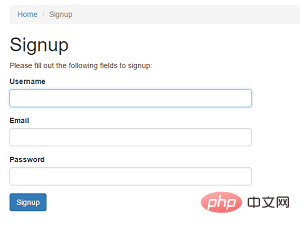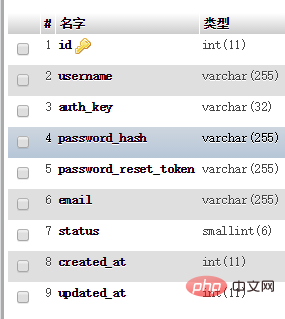How to register in yii

Registration
In the advanced template, enter the frontend/index.php?r=site/signup page and you can see the framework’s registration page

After filling in the Username, Email and Password and clicking Signup, if the format is incorrect, the rules() function in frontend/models/SignuForm will perform preliminary verification. After all the formats are correct, The data is transferred to the actionSignup() function in frontend/controllers/SiteController. The function loads the registration information entered by the user. The signup() function in frontend/models/SignupForm.
The text quoted below is the explanation function The specific details in it will not affect the whole if you don’t read it. Because there is no folding text function, the quotation method is used. The same below. The
if (!$this->validate()) {
return null;
}signup() function first calls the validate() function in yii2/base/Model. Verification
The first step is to clear the error message when using the rules() function in frontend/models/SignuForm when the user inputs
if ($clearErrors) {
$this->clearErrors();
}The second step is that the beforeValidate() function triggers the beforeValidate event and returns true
The third step, set the scenario, the default is default
The fourth step, because the $attributeNames here is null,
$attributeNames = $this->activeAttributes();
returns after execution
array (3) { [0]=> string(8) "username" [1]=> string(5) "email" [2]=> string(8) >"password" }
The fifth step, $this->getActiveValidators() will get the 11 validation rules in rules() in frontend/models/SignuForm to validateAttributes() for verification
Six steps, execute the afterValidate() function to trigger the afterValidate event
Finally, if all verifications pass, $this->hasErrors() is false, so the function finally returns true
Let’s take a look at the fields of the data table user

The user has entered username, password and email. How does the Yii2 framework generate other fields? Let’s look at password_hash first. The password generation in the signup function in SignupFrom is the setPassword function, which is in common/models/User. The setPassword function calls the generatePasswordHash function of each rule in yii2/base/Security.
if (function_exists('password_hash')) {
/** @noinspection PhpUndefinedConstantInspection */
return password_hash($password, PASSWORD_DEFAULT, ['cost' => $cost]);
}If there is, use the password_hash function for encryption. If PHP does not have a password_hash function, use the crypt function for encryption. The initial judgment is that it is to be compatible with PHP versions lower than 5.5. After all, versions greater than 5.5 only begin to have it. password_hash function
common/models/User's signup() function will continue to generate an auth key after encrypting the password. The auth key is the verification information when the user clicks remember me when logging in.
The auth key generation method is also generateRandomString in yii2/base/Security. generateRandomString calls the generateRandomKey function. If your PHP version is 5.2~5.6 or 7, use random_bytes to generate a 32-word Section string, if not, when the system you are using is windows and OpenSSL is installed, the openssl_random_pseudo_bytes function will be called to generate it. If you do not install OpenSSL, mcrypt_create_iv will be used to generate it.
If the system you are using is not Windows, you need to call /dev/urandom. FreeBSD system is special. It will call /dev/random, and then call the stream_set_read_buffer method to generate an 8-byte character file. After generation , read 32 bytes in the file through the fread function, and then return the data.
password_reset_token is empty when the user registers. It is generated when the user forgets the password and clicks reset it on the login page. It is used for verification when the user resets the password after sending an email.
status is defined in common/models/User
const STATUS_DELETED = 0; const STATUS_ACTIVE = 10;
The status in rules defaults to 10 when a user registers,
created_time and updated_time are also in common/models/ The
user's data generated in the behaviors() function in User is verified to be qualified, plus the data generated by the framework, and then stored in the user table of the data.
Recommended learning: yii framework
The above is the detailed content of How to register in yii. For more information, please follow other related articles on the PHP Chinese website!

Hot AI Tools

Undresser.AI Undress
AI-powered app for creating realistic nude photos

AI Clothes Remover
Online AI tool for removing clothes from photos.

Undress AI Tool
Undress images for free

Clothoff.io
AI clothes remover

Video Face Swap
Swap faces in any video effortlessly with our completely free AI face swap tool!

Hot Article

Hot Tools

Notepad++7.3.1
Easy-to-use and free code editor

SublimeText3 Chinese version
Chinese version, very easy to use

Zend Studio 13.0.1
Powerful PHP integrated development environment

Dreamweaver CS6
Visual web development tools

SublimeText3 Mac version
God-level code editing software (SublimeText3)

Hot Topics
 1386
1386
 52
52
 How to use PHP framework Yii to develop a highly available cloud backup system
Jun 27, 2023 am 09:04 AM
How to use PHP framework Yii to develop a highly available cloud backup system
Jun 27, 2023 am 09:04 AM
With the continuous development of cloud computing technology, data backup has become something that every enterprise must do. In this context, it is particularly important to develop a highly available cloud backup system. The PHP framework Yii is a powerful framework that can help developers quickly build high-performance web applications. The following will introduce how to use the Yii framework to develop a highly available cloud backup system. Designing the database model In the Yii framework, the database model is a very important part. Because the data backup system requires a lot of tables and relationships
 Symfony vs Yii2: Which framework is better for developing large-scale web applications?
Jun 19, 2023 am 10:57 AM
Symfony vs Yii2: Which framework is better for developing large-scale web applications?
Jun 19, 2023 am 10:57 AM
As the demand for web applications continues to grow, developers have more and more choices in choosing development frameworks. Symfony and Yii2 are two popular PHP frameworks. They both have powerful functions and performance, but when faced with the need to develop large-scale web applications, which framework is more suitable? Next we will conduct a comparative analysis of Symphony and Yii2 to help you make a better choice. Basic Overview Symphony is an open source web application framework written in PHP and is built on
 Data query in Yii framework: access data efficiently
Jun 21, 2023 am 11:22 AM
Data query in Yii framework: access data efficiently
Jun 21, 2023 am 11:22 AM
The Yii framework is an open source PHP Web application framework that provides numerous tools and components to simplify the process of Web application development, of which data query is one of the important components. In the Yii framework, we can use SQL-like syntax to access the database to query and manipulate data efficiently. The query builder of the Yii framework mainly includes the following types: ActiveRecord query, QueryBuilder query, command query and original SQL query
 How to use Yii3 framework in php?
May 31, 2023 pm 10:42 PM
How to use Yii3 framework in php?
May 31, 2023 pm 10:42 PM
As the Internet continues to develop, the demand for web application development is also getting higher and higher. For developers, developing applications requires a stable, efficient, and powerful framework, which can improve development efficiency. Yii is a leading high-performance PHP framework that provides rich features and good performance. Yii3 is the next generation version of the Yii framework, which further optimizes performance and code quality based on Yii2. In this article, we will introduce how to use Yii3 framework to develop PHP applications.
 Yii2 vs Phalcon: Which framework is better for developing graphics rendering applications?
Jun 19, 2023 am 08:09 AM
Yii2 vs Phalcon: Which framework is better for developing graphics rendering applications?
Jun 19, 2023 am 08:09 AM
In the current information age, big data, artificial intelligence, cloud computing and other technologies have become the focus of major enterprises. Among these technologies, graphics card rendering technology, as a high-performance graphics processing technology, has received more and more attention. Graphics card rendering technology is widely used in game development, film and television special effects, engineering modeling and other fields. For developers, choosing a framework that suits their projects is a very important decision. Among current languages, PHP is a very dynamic language. Some excellent PHP frameworks such as Yii2, Ph
 Yii2 Programming Guide: How to run Cron service
Sep 01, 2023 pm 11:21 PM
Yii2 Programming Guide: How to run Cron service
Sep 01, 2023 pm 11:21 PM
If you're asking "What is Yii?" check out my previous tutorial: Introduction to the Yii Framework, which reviews the benefits of Yii and outlines what's new in Yii 2.0, released in October 2014. Hmm> In this Programming with Yii2 series, I will guide readers in using the Yii2PHP framework. In today's tutorial, I will share with you how to leverage Yii's console functionality to run cron jobs. In the past, I've used wget - a web-accessible URL - in a cron job to run my background tasks. This raises security concerns and has some performance issues. While I discussed some ways to mitigate the risk in our Security for Startup series, I had hoped to transition to console-driven commands
 PHP development: Use Yii2 and GrapeJS to implement back-end CMS and front-end visual editing
Jun 15, 2023 pm 11:48 PM
PHP development: Use Yii2 and GrapeJS to implement back-end CMS and front-end visual editing
Jun 15, 2023 pm 11:48 PM
In modern software development, building a powerful content management system (CMS) is not an easy task. Not only do developers need to have extensive skills and experience, but they also need to use the most advanced technologies and tools to optimize their functionality and performance. This article introduces how to use Yii2 and GrapeJS, two popular open source software, to implement back-end CMS and front-end visual editing. Yii2 is a popular PHPWeb framework that provides rich tools and components to quickly build
 How to convert yii objects into arrays or directly output to json format
Jan 08, 2021 am 10:13 AM
How to convert yii objects into arrays or directly output to json format
Jan 08, 2021 am 10:13 AM
Yii framework: This article introduces Yii's method of converting objects into arrays or directly outputting them into json format. It has certain reference value and I hope it can help you.




